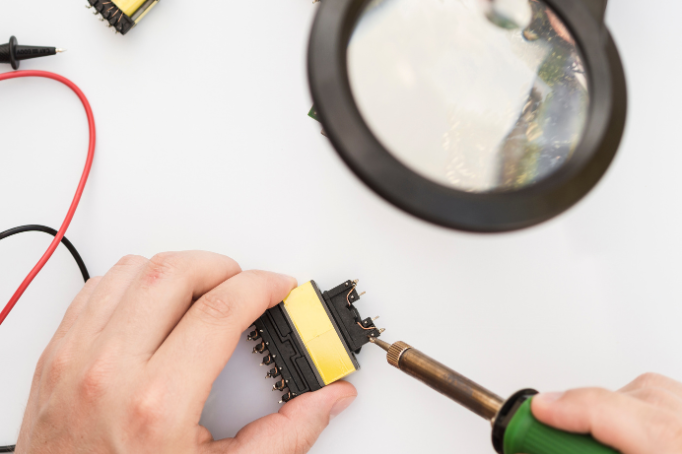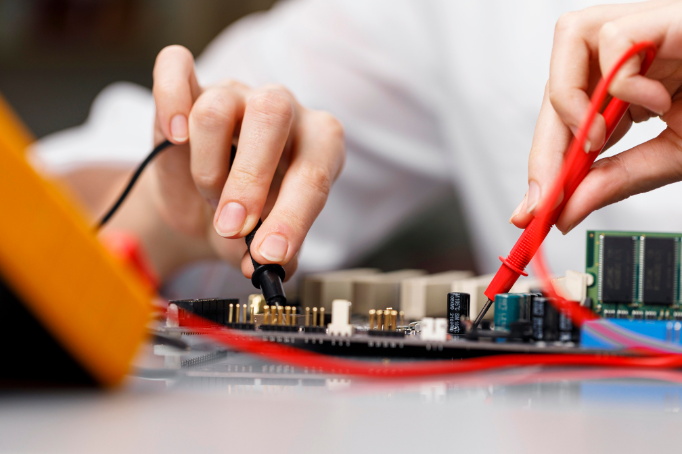Voltage regulator integrated circuits (ICs) may not be the most glamorous component in the world of electronics, but they are one of the most important components that help devices to work in the best possible ways without experiencing any issues. These ICs, although less well-known, provide numerous features, such as component protection and energy savings. Learning how they function and the unique means by which they can help in minimizing costs and time taken should help everyone—whether an organization or hobbyist—make better decisions concerning their projects.
Understanding Voltage Regulator ICs
A voltage regulator IC is a controlling circuit that stabilizes the output voltage and is immune to changes in the input voltage as well as the condition of the load. Voltage regulators are of different categories, which include linear and switching voltage regulators, and they have their specialized uses. Translating arbitrary input voltages to a constant output voltage helps to provide a stable and consistent power supply to other electronic devices such that none of them heats or damage due to the instabilities of voltage.
A voltage regulator IC can be used in power supplies, industrial equipment, automobiles, and everyday consumer electronics and appliances, including mobile phones, laptops, or PCs. These devices have a critical job: to regulate voltage delivered across each component and to prevent dangerous levels of voltage from ever appearing at its terminals, irrespective of input voltage variation or varying loads.

Time and Cost Savings of Voltage Regulator ICs
Increased Device Longevity
Pulse varying produces a degrading impact on electronic components in the long run. That is, when a device experiences repeated power spikes, it may deteriorate more quickly internally and will not last long. Voltage regulator integrated circuits assist in minimizing such variations, thus ensuring that devices are not exposed to these extra voltages that may harm them. These integrated circuits guarantee a constant power supply and hence protect the costly components to hail more years to the device’s use.
In addition, physical breakdown of devices or daily malfunctions that require repair or replacement means much time and money wasted, thereby making voltage regulators more economical.
Improved Energy Efficiency
Voltage regulators have functions to do with energy consumption, and voltage in switching regulator design is more efficient than linear regulators. The excess input voltage can be converted into usable energy by using switching regulators and hence enhances the system efficiency. This reduction in the wasted energy benefits in the reduction of electricity consumption costs while, on the other hand, serving the large power supplies necessitates additional large power supplies, which are very costly to purchase, thus reducing the initial investment costs.
Energy-efficient electronics are also famous due to their low energy impact on the environment. This type of equipment is particularly used in industries where efficiency in using electrical energy is paramount, like the telecommunications industries or data centres, and hence, in the long run, an operation that incorporates this type of voltage regulator can be very costly.
Simplified Power Supply Design
Power supply design can be somewhat challenging, although the task may take a lot of time, particularly for cases where varying input voltages are involved or varying load requirements. This is made easier by voltage regulator ICs that offer a constant output voltage, hence making it easier for designers to work on other performances of the circuit. These advantages include overcurrent protection and thermal protection, making the design of an extra fault protection component unnecessary.
This, in addition to facilitating the acceleration of the design stage, also cuts down the number of parts needed to be built, eliminates a great deal of manufacturing intricacies, and reduces the risk of making errors. It is far preferable to have fewer components within a design due to the process of assembly and issue identification. This leads to short production cycles, mainly for large-scale consumer electronics, and reduced time spent reworking and maintaining the defective products.
Reduced Cooling Requirements
One of the problems in electronics is heat dissipation: the overheating of components is dangerous for device operation. Voltage regulator ICs, especially switching voltage regulators, offer higher efficiency as compared to other measured techniques of power regulation, which contributes to reduced heat generation. Though easy to implement and cheap, linear regulators waste more heat because they regulate voltage by use of a resistor. Therefore, as we shall see later, while conventional voltage regulators vary voltage by using a fixed amount of voltage drop, switching regulators control voltage in a way that minimizes wasted electrical energy in the form of heat.
Voltage regulators decrease the heat produced, which ultimately has an impact on eliminating restricted cooling methods, including fans and heat sinks. It is especially useful in small portable electronics where small spaces restrict the incorporation of extra heat dissipation equipment. That is why, with voltage regulators, a designer can expect to use smaller and less expensive cooling systems.
Minimized System Downtime
They may cause the system to fail and lead to downtimes in critical applications, to name but a few. To businesses, such downtime means lost time and, therefore, lost opportunity to make that all-important sale or make some significant progress in the progress of the business. Voltage regulator integrated circuits ensure that the above disruptions do not happen by controlling the voltage levels as they dictate when there is a sudden surge or weakness in an electrical supply.
Companies can greatly limit the incidence of any circuit failure or any type of shutdown by adding voltage regulators to their circuits. This not only guarantees a more efficient and continuous function but also reduces the time that could be used to seek technical support in case of breakdowns resulting from the instabilities of power supplies.
Enhanced Portability and Flexibility
Notebook computers, tablet computers, and smartphones have different power characteristics. They are normally operated on backup battery power that changes in voltage as the battery discharges. Due to voltage regulator ICs, those devices can work effectively as they draw power even as the battery is charging or discharging. The capacity to tolerate a large number of input voltage configurations means that portable power supplies can continuously offer strong performance up to the last few percent of battery capacity.
For consumers, this means less disruption of device usage and less often to recharge. To the manufacturers, voltage regulators help to decrease the amount of circuiting that would be required to manage battery levels, thereby allowing efficient production of more compact equipment. This makes a difference in the versatile manufacturing of products where the market is flooded with new products at short spans with less cost.

Protection Against Voltage Spikes and Overcurrent
High voltage fluctuations and over-current conditions pose a devastating danger to such particulars by causing damage to highly sensitive parts that may cost much to replace. Such advantages as overcurrent protection, short circuit protection, and overvoltage protection are usually integrated into series voltage regulator ICs to limit these dangers that endanger connected components.
Incorporating these features, voltage regulators eliminate further damage to electronics, especially in those applications where devices are sensitive to power supply variations, for example, automotive or industrial ones. These are protective measures that help minimise the likelihood of component failure, meaning we minimize the constant costs of repair and the time that is spent on diagnostics and repair.
Reduced Inventory and Parts Management
Integrating voltage regulator ICs makes it easy to decrease the number of ICs that are used for delivering a stable voltage power supply, thus decreasing the BOM count and making it easier to manage the stock. It is most advantageous in the production line that utilizes highly varied inventories of parts and components.
With more flexible voltage regulators available, manufacturers also reduce the time, money, inventory, and management burdens inherent in component selection. This simplifies procurement in that one does not have to worry about shortages or delays of the parts needed, hence ensuring efficient schedules are maintained.
Compatibility with Renewable and Alternative Power Sources
As with photovoltaic systems, voltage regulators are of great importance for utilizing solar or wind energy or as the dependence on fossil fuels continues to decline. Such sources tend to produce ranging voltage signals that may be influenced by changes in the surrounding environment. Voltage regulator ICs provide devices that are supplied with power by renewable means of electricity in a continuous flow of power even if the flow of input voltage varies.
This capability enables firms to look for cheaper renewable energies for their devices without compromising on the product’s quality. These devices enable the US to incorporate new power sources into its electronics, opening up a path toward more sustainable energy systems that will ultimately lower long-term expenses for electronics.
Versatility Across Applications
Voltage regulators are universal devices applied in virtually every industry, including automotive, consumer electronics, telecommunications, and various industries focused on automation. This ability makes them suitable for most operation voltage inputs, and reliable output makes them useful in many circuits ranging from huge industrial machines to portable mini devices. This flexibility aids in enabling various companies to cement standard physical interfaces across multiple products to reduce the design variety across different products.
Conclusion
There are many advantages that voltage regulator ICs have that can help one save time and cost, and that should make it a mandatory component in almost every electronic design. They help to improve the stability of voltage output and prevent it from power surges and dips while increasing its efficiency, which improves the product’s lifespan, fail rate, and frequency with which it needs to be refurbished and replaced. Also, in that they facilitate easier design, decrease the need for cooling, and lessen the number of parts dealt with, they assist in designs for manufacture and recovery and accelerate the manufacturing procedures.
Voltage-regulator ICs can help simplify power-supply designs for large industrial systems as well as miniature consumer devices while lowering overall power costs and enhancing device performance. In the current world where competitiveness and dependability are becoming the order of the day, the use of voltage regulators is one of the ways through which economical and reliable electronics are developed.
About The Author
Elena Tang
Hi, I’m Elena Tang, founder of ESPCBA. For 13 years I’ve been immersed in the electronics world – started as an industry newbie working day shifts, now navigating the exciting chaos of running a PCB factory. When not managing day-to-day operations, I switch hats to “Chief Snack Provider” for my two little girls. Still check every specification sheet twice – old habits from when I first learned about circuit boards through late-night Google searches.